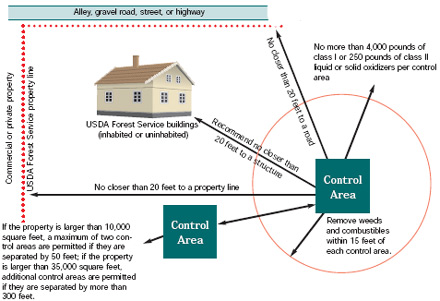Everyday Hazmat User's Training Guide
Section III Hazardous Materials Management (continued)
Oxidizers
- Definitions
- Indoor Storage
- Outdoor Storage
- Permitting
- Transportation
- Examples of Oxidizers Used in the USDA Forest Service
Oxidizers can provide oxygen, allowing other materials to ignite more easily and burn more violently. The classes of oxidizers have specific regulations regarding their storage, use, and disposal. Only NFPA classes I and II are addressed in these guidelines; if you have products in classes III or IV, be sure to check with your unit�s hazmat coordinator. Oxidizers in classes III or IV are more dangerous and have additional requirements.
Definitions
Oxidizers�What Are They?
Most USDA Forest Service units have only NFPA class I (for example, ammonium nitrate fertilizers) or class II (for example, potassium permanganate) oxidizers. NFPA class III oxidizers react more violently than those in classes I and II. Class IV oxidizers are explosive and react significantly more violently. Watch for products with chemicals that end in ite, ate, or ide. These endings may indicate oxidizers.
Use the MSDS to determine which class of oxidizer you have.
- See Hazardous Materials Storage Cabinets
- See Keeping Incompatible Hazardous Materials Separated
- See The Transition to Hazardous Waste
- See Hazardous Product Containers
Oxidizers�The Dangers
Oxidizers present a health hazard to workers. Always refer to the MSDS to understand the personal protective equipment needed to handle an oxidizer safely and the actions needed in case of accidents.
Storage Cabinets
Proper storage cabinets can protect workers and the environment and can allow you to store larger quantities of an oxidizer safely.
Indoor Storage
Storing class I and II oxidizers inside buildings is acceptable as long as certain precautions are taken; check with your local fire marshal for additional restrictions. We will use the concept of a control area to clarify storage and use restrictions. Control areas are separate areas where oxidizers are stored or used. If you have class III or IV oxidizers, contact your hazmat coordinator for specific guidance.

Click on image for larger descriptive view
Other Important Requirements
- Control area ventilation is not required, but
is recommended.
- Secondary containment is not required, but is recommended.
- Noncombustible
shelving and liquid-tight floors are a requirement; you can use wood shelving
if the shelving is at least 1 inch thick and coated.
- All products should
be labeled with an oxidizer label.
- Each control area must have a NO SMOKING sign.
- Each
control area must have a hazard identification sign.
- All containers must
be sound and tightly closed at all times; if you smell a product in your
cabinet or room, either a container is not securely closed or there has been
a spill.
- Control
areas can be in offices, basements, and garages; storing oxidizers in USDA
Forest Service residences is not recommended.
- A maximum of 200 pounds (solid) or 20 gallons of class III oxidizers (for example, calcium hypochlorite) may be stored for maintenance, operations, or sanitation. Storage containers and methods must be approved by the local fire marshal.
Outdoor Storage
Oxidizers can be stored outside as well as inside, as long as storage does not degrade the quality of the product. You can have up to two control areas, possibly more, but each control area has restrictions. Keeping the total oxidizer volumes stored below the allowed levels (4,000 pounds of class I oxidizers or 250 pounds of class II oxidizers) will avoid more complicated storage requirements.

Click on image for larger descriptive view
Other Important Requirements
- Secondary containment is not required, but
is recommended.
- All products should be labeled with an oxidizer label.
- Each
control area must have a NO SMOKING sign.
- Each control area must have a hazard
identification sign.
- All containers must be sound and tightly closed at all times; if you smell a product in your cabinet or room, either a container is not securely closed or there has been a spill.
